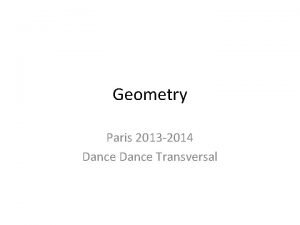NASAs MMS Uncovers Dance of Electrons in Space

- Slides: 1

NASA’s MMS Uncovers Dance of Electrons in Space With two years under its belt, the NASA Heliophysics Magnetospheric Multiscale (MMS) mission has been revealing new and surprising phenomena near Earth. These discoveries enable us to better understand Earth’s dynamic space environment and how it affects our satellites and technology. Swarms of electrons are buzzing through Earth’s magnetosphere all the time. These electrons spiral and dive around the planet in a complex dance dictated by magnetic and electric fields. When they penetrate into the magnetosphere and close enough to Earth, high-energy electrons can damage satellites in orbit and trigger auroras. Electrons in a strong magnetic field usually exhibit a simple behavior: They spin tight spirals along magnetic field lines. In a weaker field region, where the direction of the magnetic field reverses, the electrons move more freely — bouncing and swaying back and forth in a type of movement called Speiser motion. New MMS results show, for the first time, what happens in an intermediate strength field. Electrons in these field strengths move in a hybrid, meandering motion — spiraling and bouncing about before being ejected from the region. This motion takes away some of the field’s energy and plays a key role in magnetic reconnection – a dynamic process, which can explosively release large amounts of stored magnetic energy. As MMS flew around Earth, it passed through an area of a moderate strength magnetic field where electric currents run in the same direction as the magnetic field. Such areas are known as intermediate guide fields. While inside the region, the instruments recorded a curious interaction of electrons with the current sheet, the thin layer through which the current travels. As the incoming particles encountered the region, they started gyrating in spirals along the guide field – like they do in a strong magnetic field – but in larger spirals. electron escaping This is a still capture from this animation produced by the NASA GSFC SVS studio. In an intermediate strength magnetic guide field, the electrons spiral along the field, gaining energy until they are ejected from the reconnection layer. The MMS observations saw signatures of the particles gaining energy from the electric field. Before long, the accelerated particles escaped the current sheet, and formed high-speed jets. In the process, they took away some of the field’s energy, and caused it to gradually weaken. The new results help the scientists better understand the role of electrons in reconnection and how magnetic fields lose energy. MMS measures the electric and magnetic fields it flies through, and counts electrons and ions, measuring their energies and directions of motion. With four spacecraft flying in a compact, pyramid formation, MMS is able to see fields and particles in three dimensions and look at small-scale particle dynamics in a way never before achieved.

